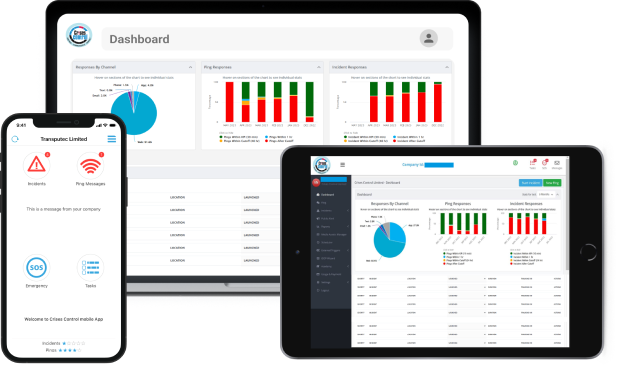Written by Anneri Fourie | Marketing Executive
Disasters can strike at any time, jeopardising your employees’ safety, operational efficiency, and even your company’s reputation. Here’s where a robust emergency response plan comes in. An emergency response plan is a strategic roadmap outlining how your organisation will respond to various emergencies, mitigating risks and ensuring a swift recovery.
This blog delves into the importance of emergency response plans, the steps involved in creating one, and how Crises Control can be your partner in navigating unforeseen circumstances.
What is an Emergency Response Plan and Why is it Important?
An emergency response plan is a comprehensive, well-documented strategy that outlines the actions a business must take to prepare for, respond to, and recover from emergencies. These emergencies could range from natural disasters like earthquakes and floods to man-made crises such as fires, chemical spills, or even cyberattacks.
The Importance of an Emergency Response Plan
Why every business needs a documented emergency response plan:
- Ensures Safety: The primary goal is to protect the lives of employees and visitors.
- Minimises Damage: Effective plans reduce the impact on physical and digital assets.
- Maintains Business Continuity: By having a plan, businesses can continue critical operations with minimal disruption.
- Compliance: Many industries are regulated and require formal emergency response plans.
- Reduces Liability: Demonstrating preparedness can mitigate legal repercussions post-crisis.
6 Steps on How to Create an Emergency Response Plan
1. Conduct a Risk Assessment
The first step in creating an emergency response plan is to conduct a thorough risk assessment. Identify potential emergencies that could affect your business. This includes both natural and human-made disasters. Analyse their probability and potential impact.
2. Develop an Evacuation Plan
An evacuation plan is a critical component of your emergency response strategy. Define clear, actionable steps for safe and efficient evacuation. Ensure there are designated assembly points, and every employee knows the evacuation routes.
3. Establish Communication Protocols
Effective communication during an emergency can save lives. Develop a communication plan that includes:
- Emergency Contacts: Maintain updated contact lists for all employees.
- Communication Tools: Utilise tools like Crises Control to send mass notifications swiftly.
- Information Flow: Define who communicates with whom, ensuring clear information pathways.
4. Assign Roles and Responsibilities
Designate specific roles and responsibilities to team members. Ensure that everyone knows their duties during an emergency. Conduct regular training sessions and drills to keep everyone prepared.
5. Prepare Emergency Supplies
Stock essential supplies that will be needed during an emergency. This includes first aid kits, flashlights, batteries, water, non-perishable food, and personal protective equipment (PPE).
6. Regular Review and Training
An emergency response plan is not a one-time document. It needs regular reviews and updates. Conduct annual reviews or after significant changes in your business operations. Regular training and drills will ensure everyone remains prepared.
How Can Crises Control Help?

Crises Control is designed to streamline the process of emergency response planning and execution. Here’s how we can assist:
Advanced Communication Tools
Our platform offers robust communication tools that ensure all employees receive timely alerts during an emergency. With features like mass notifications, two-way communication, and real-time updates, you can keep everyone informed and safe.
Comprehensive Training and Support
Crises Control provides extensive training and support to help you develop and maintain your emergency response plan. Our experts can guide you through risk assessments, planning, and conducting effective drills.
Business Continuity Management
Beyond emergency response, Crises Control supports your business continuity efforts. Our tools help you plan for disruptions, ensuring that critical operations continue with minimal impact.
Customisable Plans
Every business is unique, and so are its risks. Crises Control allows you to customise your emergency response plan to address specific threats and operational needs. With Crises Control’s Incident Plan Builder you can choose from 200+ predefined templates or create your own.
Real-Time Incident Reporting
Crises Control enables real-time incident reporting, allowing you to document and manage incidents as they happen. This feature ensures accurate record-keeping, aids in compliance, and helps in post-incident analysis to improve future response strategies.
Integration with Existing Systems
Crises Control can seamlessly integrate with your existing systems, enhancing your overall emergency preparedness without disrupting current workflows. This integration ensures that your emergency response plan works in harmony with other business processes, providing a comprehensive approach to crisis management.
Scalable Solutions for Any Size Business
Crises Control provides scalable solutions that cater to businesses of all sizes, from small enterprises to large corporations. Our flexible platform adapts to your organisation’s needs, ensuring that as your business grows or evolves, your emergency response capabilities can scale accordingly without compromising effectiveness or efficiency.
Conclusion: Secure Your Business Future with Crises Control
An emergency response plan is vital for any business aiming to protect its people and assets while ensuring continuity. By following the steps outlined in this guide, you can create a robust plan that prepares your organisation for various emergencies.
Crises Control stands ready to assist you in this journey. With our advanced tools and expert support, you can develop, implement, and maintain an effective emergency response plan tailored to your business needs. Contact us today to get a free personalised demo and see how we can help secure your business future.
Request a FREE Demo








